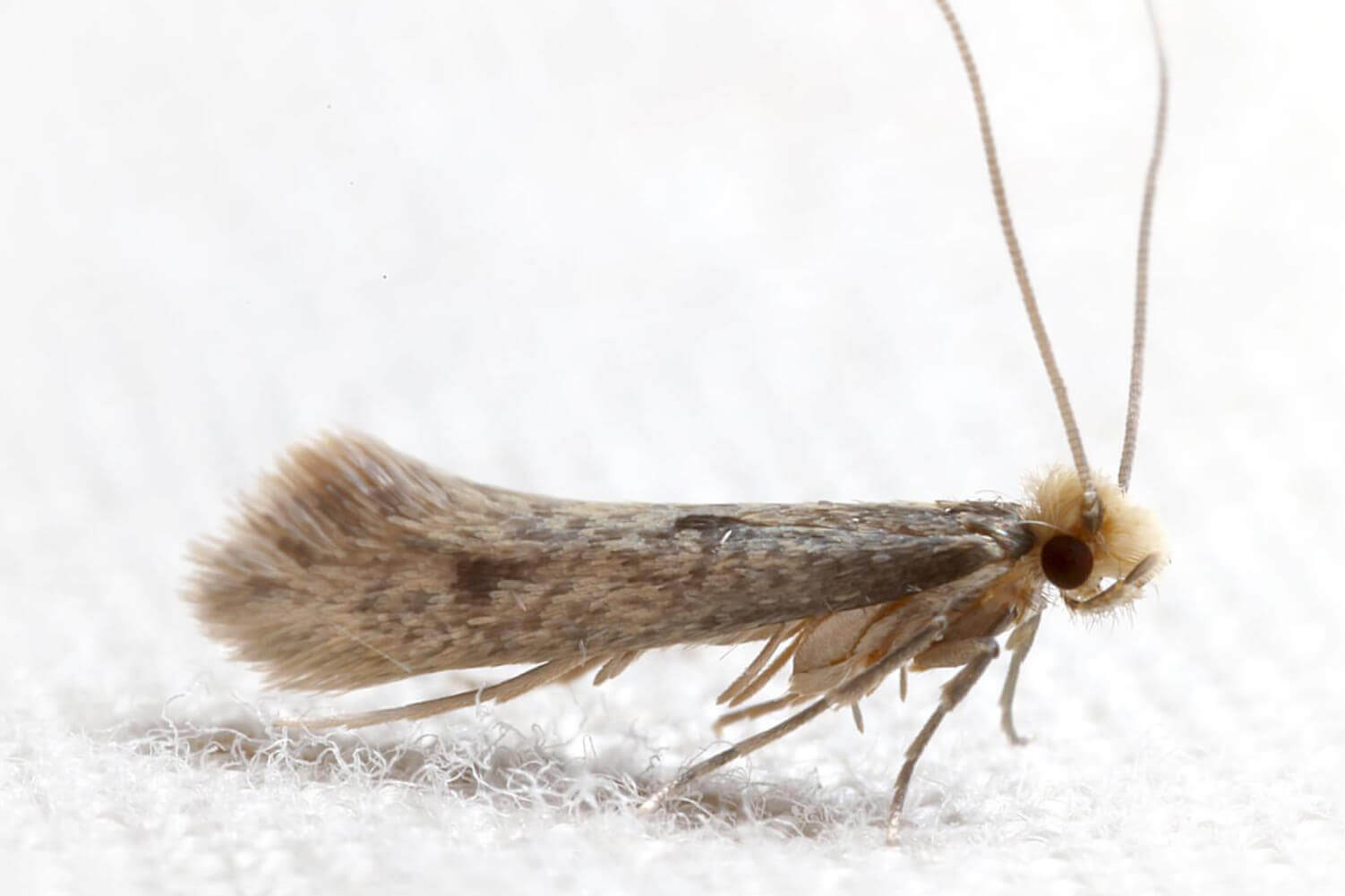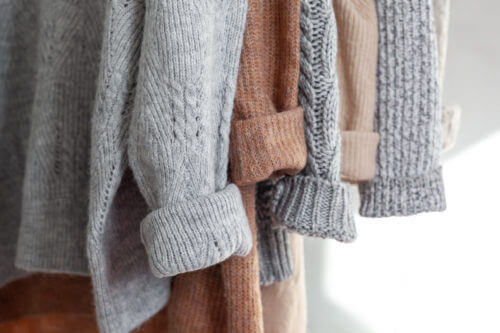Clothes Moth Facts & Information
Everything you need to know about clothes moths
What Do Clothes Moths Look Like

Adults have silver grey/brown and gold-colored wings which are held close to the body. Both fore and hind wings have a fringe of hairs along the edges. The forewings are gold or brown with one large dark spot and two smaller dark spots, although these often rub off on older specimens. Unlike other moths, they shun the light and prefer your nice, dark closet which is why they are difficult to spot. A professional moth exterminator knows just where to look.
Clothes moth adults do not feed so they cause no injury to fabrics. However, the adults lay about 40-50 pinhead-sized eggs on vulnerable substrates, which in turn, hatch into the fabric-eating larvae. The larval stage of clothes moths are creamy-white caterpillars up to 1/2-inch long. Development time before transforming into a moth varies greatly (from one month to as much as two years), depending on temperature, food availability, and other factors. Webbing clothes moth larvae spin silken tubes or patches of webbing as they move about on the surface of infested materials. They often feed within folds of fabric and other concealed areas. As larvae graze along the surface, threadbare spots occur where fibers are removed at the base. On animal (taxidermy) mounts, clumps of hair will often detach from the skin. Also present are tiny fecal pellets.
After mating, the female moth can lay up to 300 eggs before dying. Moth eggs hatch in four to 10 days during the summer but may take several weeks to hatch in the winter. The male moths live on for about a month to mate with other females, creating hundreds more of these tiny starving pests. The moth larva begins feeding right after hatching from the egg. There are multiple larval stages which get progressively bigger through molting. The development time can vary from one month to three depending on food source and room temperature.
When the larvae of the moth are ready to pupate — beginning the process by which they develop into adult moths — they move up and attach themselves to a surface with a silk thread from which the pupa hangs. This is one way pest control service technicians know which species they are dealing with if they cannot find adults. Pupation for webbing clothes moth larvae occurs inside a silken cocoon, which is usually found in places where the larvae have been feeding. Finding one of these cocoons in a drawer, closet or storage area is a sure sign of possible moth infestation.Not the moth you have?
Clothes moth adults do not feed so they cause no injury to fabrics. However, the adults lay about 40-50 pinhead-sized eggs on vulnerable substrates, which in turn, hatch into the fabric-eating larvae. The larval stage of clothes moths are creamy-white caterpillars up to 1/2-inch long. Development time before transforming into a moth varies greatly (from one month to as much as two years), depending on temperature, food availability, and other factors. Webbing clothes moth larvae spin silken tubes or patches of webbing as they move about on the surface of infested materials. They often feed within folds of fabric and other concealed areas. As larvae graze along the surface, threadbare spots occur where fibers are removed at the base. On animal (taxidermy) mounts, clumps of hair will often detach from the skin. Also present are tiny fecal pellets.
After mating, the female moth can lay up to 300 eggs before dying. Moth eggs hatch in four to 10 days during the summer but may take several weeks to hatch in the winter. The male moths live on for about a month to mate with other females, creating hundreds more of these tiny starving pests. The moth larva begins feeding right after hatching from the egg. There are multiple larval stages which get progressively bigger through molting. The development time can vary from one month to three depending on food source and room temperature.
When the larvae of the moth are ready to pupate — beginning the process by which they develop into adult moths — they move up and attach themselves to a surface with a silk thread from which the pupa hangs. This is one way pest control service technicians know which species they are dealing with if they cannot find adults. Pupation for webbing clothes moth larvae occurs inside a silken cocoon, which is usually found in places where the larvae have been feeding. Finding one of these cocoons in a drawer, closet or storage area is a sure sign of possible moth infestation.Not the moth you have?
How Did I Get Clothes Moths
Clothes moths are attracted to soiled, dirty clothing and the pungent sweaty smells they can emit. They are particularly attracted to dark, warm, humid spaces, and dirty clothing (especially unwashed items that may have lingering body oils or food residue). Making sure your dirty laundry is in a laundry basket until laundry day will help but throwing a load into the washing machine the moment it’s full will also help. If you aren’t sure if the holes are moth-caused, one way to tell is that some larvae will leave behind a web that resembles dried snot.
What Problems Do Clothes Moths Cause
Besides the obvious holes in fabric items resulting from larva grazing on the ends of fibers, clothes moths are attracted to animal carcasses. That being said, there could be a dead animal in the attic or wall voids in your home or business that needs to be cleaned up. They are attracted to soiled clothing so even if you haven’t worn something in a while, make sure to keep it in the laundry cycle. Clothes moth extermination can help for ultimate moth control.
How Can I Prevent Clothes Moths
Woolens and other susceptible items should be dry-cleaned or laundered before being stored for long periods. Cleaning kills any eggs or larvae that may be present and removes perspiration odors that tend to attract pests including clothes moths. Articles to be stored should then be packed in tight-fitting plastic bags or containers.

Valuable garments such as furs can also be protected from clothes moths by storing them in cold vaults, a service offered by some furriers and department stores. Contrary to popular belief, cedar closets or chests are seldom effective in deterring clothes moths because the seal is insufficient to maintain the correct repellent concentrations of the oil of cedar. Better to have a pest control services expert come in and help with clothes moth extermination for you.
If you decide to use moth–deterring balls, flakes, or crystals, be sure to carefully read and follow the label directions. Some of the products used in those types of DIY solutions can be hazardous if used incorrectly. Never scatter them in open closets or other areas where children or pets can reach them.
If you decide to use moth–deterring balls, flakes, or crystals, be sure to carefully read and follow the label directions. Some of the products used in those types of DIY solutions can be hazardous if used incorrectly. Never scatter them in open closets or other areas where children or pets can reach them.
Why Waltham for Clothes Moth Control
We’re passionate about keeping clothes moths out of your home or business because we live and work here – it’s our neighborhood, too. With our 130 years of experience keeping homes and businesses in Massachusetts, Connecticut, New York, Maine, Vermont, New Hampshire, and Rhode Island safe from pests, Waltham has the experience you can trust.
Satisfaction Guarantee
24-Hour Guaranteed Response
Board Certified Entomologists
Say goodbye to clothes moths.
GET MY QUOTE
“Exceptional service. Prompt and professional. Used for both business and home. Very efficient and honest.”
Agawan, MA
